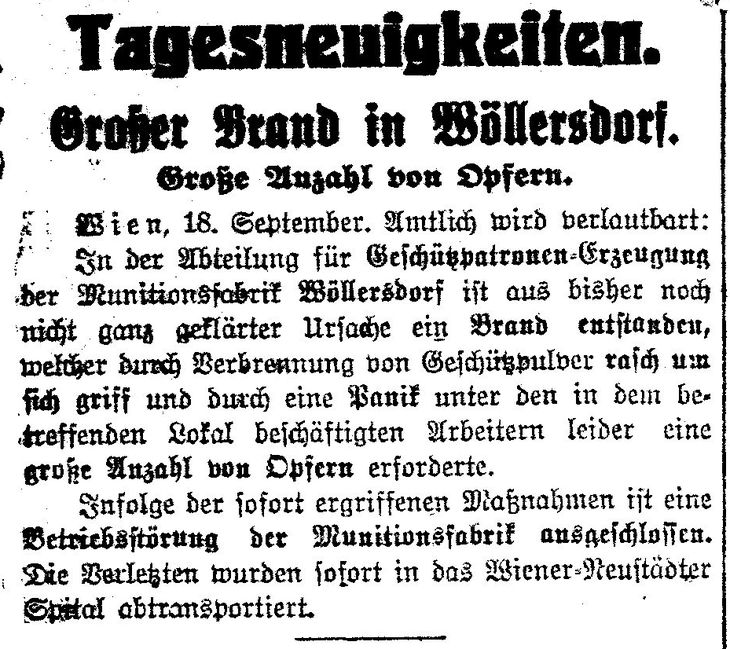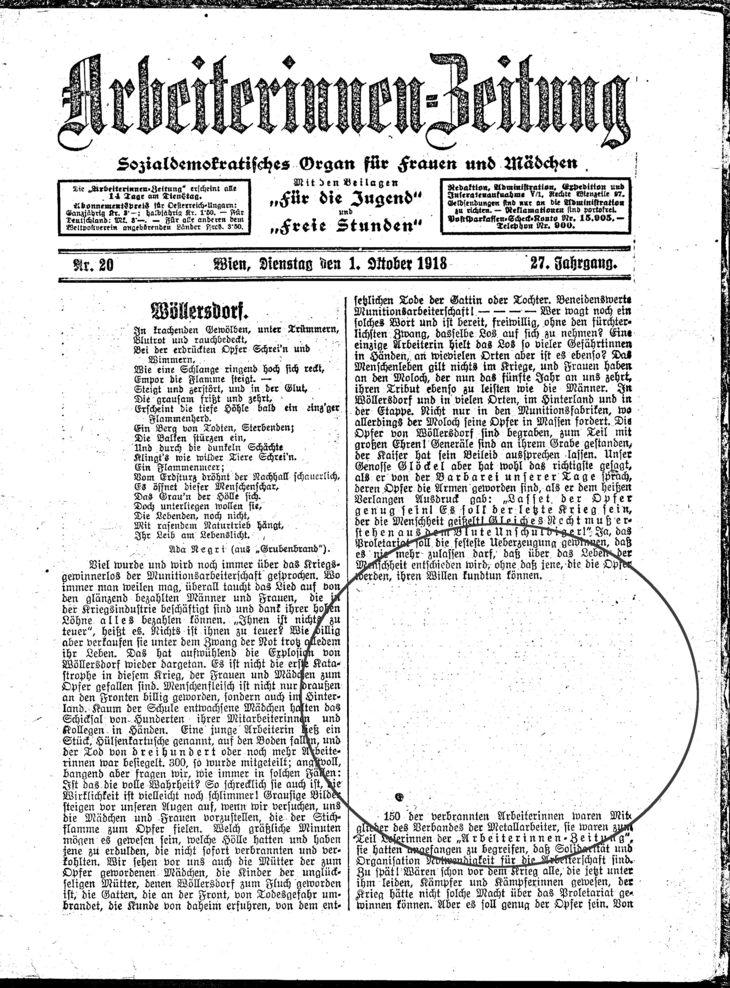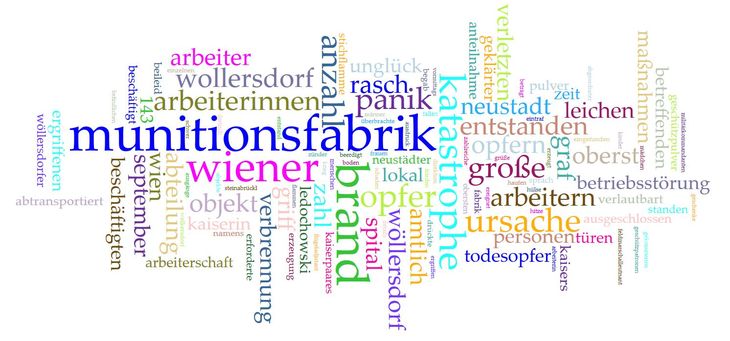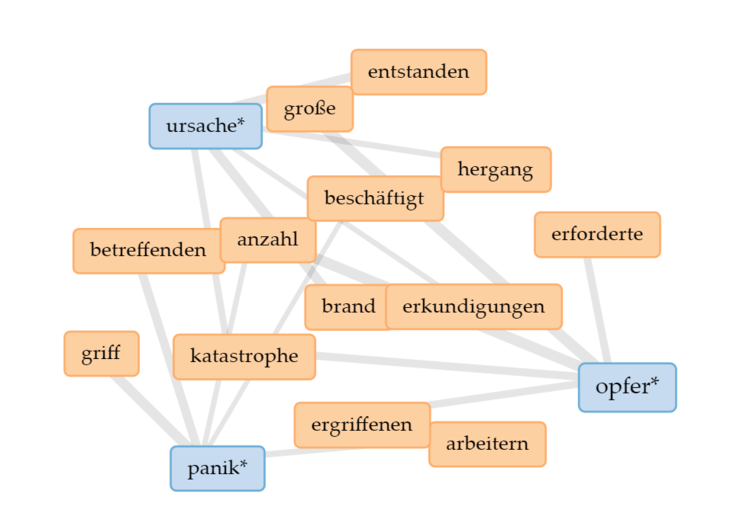Les articles du blog NewsEye sont rédigés par les membres de notre équipe projet. Parmi les thèmes traités figurent les conférences auxquelles nous assistons, des réflexions sur les questions d’actualité pertinentes, des actualités et les avancés de notre projet, ainsi que du contenu plus succinct diffusé dans le cadre de nos études de cas sur les humanités numériques ou de nos publications relatives au projet. Les articles du blog sont publiés principalement en anglais, mais néanmoins proposés de temps à autre dans la langue de prédilection du membre de l’équipe projet concerné, puisque notre petite troupe parle plusieurs langues ! Bonne lecture !
The fire of Wöllersdorf (1918) in Austrian Newspapers
As part of the case study “Nationalism and Revolutions”, our very own Barbara Klaus took a closer look at the Austrian press coverage of one of the most important incidents on Austrian territory during the First World War (1914-1918), which affected all parts of society and involved the civil population in warfare more than ever before: the fire catastrophe in the munitions factory Wöllersdorf. For this research, the digital newspapers online archive ANNO (AustriaN Newspapers Online) was used to browse Austrian Newspapers manually and via the so-called advanced search. Overall 103 articles in 37 different newspapers between the 19th of September and 2nd of October 1918 reported on the catastrophe. Even though this fire catastrophe in the munitions factory Wöllersdorf has largely disappeared from our cultural and collective memory regarding the conflict and was overlapped by other – mainly battlefront related – events, it still was in fact the largest civil disaster in Austria between 1914 and 1918. Therefore it is important to analyse historical newspaper to get deeper insights into the communication of this incident to the general public via a mass medium, which was trapped between propaganda and censorship during the First World War.
What happened?
In September 1918, in Wöllersdorf, Lower Austria, a massive fire occurred . Over 400 people – mainly young girls and women – were killed during this fire in building No. 143 at the local munitions factory; about 35 persons survived. The factory was one of the most important munition factories of the k.u.k. arms industry before and during the First World War. In this building, especially women and young girls weighed gunpowder, filled it into linen bags and combined them with detonators. Because of the precarious situation at the end of the war, the production had to be as effective and efficient as possible. Therefore, many safety precautions were abandoned and rules and regulations for occupational safety suspended.

Figure 1: Official statement in Die Neue Zeitung about the fire (19/09/1918, p. 3)
Just prior to noon at the 18th of September 1918, the fire was caused by a cartridge case that fell to the floor and generated a flash, which then rapidly set fire to the surrounding gunpowder. The number of victims was so high because most of the exits were locked to prevent the workers from leaving the factory early for lunch. Eyewitnesses spoke of corpses pilled up at the exits. Because of this fact, the fire in Wöllersdorf was repeatedly compared in the press to the Ringtheaterbrand (Ringtheater fire) in Vienna (1881), which (officially) claimed 384 victims. It wasn’t the first incident at the munitions factory Wöllersdorf. In 1913, three workers died during an explosion in one of the factory’s buildings. Four years later, in 1917, three gunpowder magazines detonated at night near Wöllersdorf. The explosion was widely heard and caused damage to buildings many kilometers away. Even among the residents in Vienna, insecurity and rear prevailed. According to several newspaper reports, 22 people died, but the official news about the disaster was hardly believed. The population at the time was convinced that several hundred people died in this accident.
What did the newspapers report – and what did they omit?
Initially, the military administration tried to minimise the impact of the accident and censored the newspaper reports about the catastrophe in September 1918. A few days later, an insight into the true extent of the tragedy was revealed. Taking a look at the newspaper articles about the fire at the munitions factory Wöllersdorf, it is obvious that official entities had a huge influence on the press coverage of the accident. In the first two days after the fire catastrophe, only short articles were published, which often contained similar (official) information about the fire. Later articles filled up to one newspaper page. Some of them contained so-called ‘white spots’ (see figure 2), which were caused by censorship. Then, 103 articles in 37 different Austrian newspapers between the 19th of September and the 2nd of October dealt with the civil disaster. This broad range of newspapers, which reported about the fire, underlines the importance of the accident felt already then.

Figure 2: ‘White Spot’ in Arbeiterinnen-Zeitung (01/10/1918, p. 1)
The word cloud (see figure 3) confirms the prior statement. It returns the most frequently used words in the investigated articles and visualizes the most prominent terms in the centre, adding less frequently used words in the surroundings. As it can be expected, the words ‘Munitionsfabrik’ (munitions factory’), ‘Brand’ (‘fire’), ‘September’ (‘September’) and ‘Opfer’ (‘victims’) and the year 1918 were often mentioned in the articles. Especially the frequent use of the words ‘Katastrophe’ (‘catastrophe’) and ‘Unglück’ (‘tragedy’) underline the fact that the accident was generally perceived as a disaster. Even though mainly women and young girls worked in this factory, the words ‘Arbeiter’ (‘worker’), ‘Arbeiterinnen’ (‘female worker’) and ‘Arbeitern’ (‘workers’) appear almost equally often in the articles, because in the first published texts, which were based on official statements (see figure 1), only the male form was used. Later on, the press coverage concentrated on the fate of the female workers. Also, the number 143 appears quite often in the articles. It refers to the number of the building, in which the accident happened. Furthermore, the term ‘rasch’ (‘rapid’) was used quite regularly in the articles to describe the quick spreading of the fire in the munitions factory. In this context it has to be noted that, although the place of the accident is often mentioned in the articles, it does not play a prominent role in the cloud, which is due to the many misspellings in the text documents.

Figure 3: Most important words in the press coverage (‘Cirrus’, Voyant Tools)
The released stories concentrated, for example, on dreadful details about the fire, financial indemnity of the surviving dependants and the funeral of the victims. But also the investigation of the cause (‘Ursache’) of the accident and the course of events (‘Hergang’) were regularly discussed in the articles. For example, the (Neuigkeits-) Welt Blatt wrote the following about the incident at the 21st of September 1918:
“The condolence of the imperial couple. On behalf of the emperor and the empress the aide-de-camp colonel count Ledochowski showed up at the Wöllersdorf munition factory and expressed to the commander of the munitions factory colonel Brandl and the confidential people of the workers the lively sympathy of the imperial couple on the calamity. Count Ledochowski then moved on to the barrack hospital as well as to the town’s hospital in Wiener-Neustadt, where he visited persons who were harmed during the catastrophe and passed on the condolences by the imperial couple and distributed gifts.”
The following figure shows some of the main words that were used in the articles regarding the high number of victims (‘Anzahl’) caused by the accident in the munitions factory. ‘Links’ is a force-directed network and it visualises the connections between words in a network. A qualitative analysis of the articles shows that especially the way the fire developed was blamed for the high number of casualties and was used as an explanation for the piled up corpses at the exits. However, only one article in the Arbeiter-Zeitung (October 2nd 1918) openly expresses that at least one of the exits was locked. It is somewhat surprising that this accusation passed the official censors. However, also articles in other newspapers, such as the Innsbrucker Nachrichten (20th of September 1918) and Illustrierte Kronen-Zeitung (21st of September 1918), report about rumours regarding locked doors at the munitions factory. As already pointed out at the beginning of the blog post, the locked gates were actually one of the main causes for the high death toll. The already mentioned text in the Arbeiter-Zeitung (October 2nd 1918), which was a social democratic newspaper, furthermore condemns the working conditions in the factory and the building itself, which – even if the doors hadn’t been locked – had too few and too small exits. The building was described as a ‘Menschenfalle’ (‘peoples trap’) in this context.

Figure 4: Terms connected to the high number of victims. (‘Links’, Voyant Tools)
The end of the story?
However, after one week, fewer and fewer reports were published and after just fourteen days, the media coverage of the fire stopped completely. Figure 5 shows that in the first days after the accident, many short articles were published and later on the number of articles decreased, but the extent of these increased. Finally, on the 1st and 2nd of October only one long article was published each day. It could be argued that the military administration prevented further reports about the accident, but it is more likely that – in the last weeks of the First World War – other news were more important.
Figure 5: Timeline of published articles and number of words about the catastrophe (1918)
Later on, a memorial was erected to commemorate the victims of this catastrophe. However, in the last 100 years, as already indicated, the largest civil disaster during the First World War in Austria sank into oblivion. The centenary of the accident was used to draw public attention to the incident. Furthermore, four new memorial stones (the unknown grief, the catastrophe, the victims and the commemoration) were erected. But Austria wasn’t the only country which had to record such accidents. For example, in Great Britain 134 people were killed at a TNT explosion in the National Shell Filling Factory (Chilwell) in 1918. Also in this case a memorial was erected and at the centenary of the explosion (2018) the mass grave, in which about 100 unidentified bodies were buried, was renovated. Both endeavours to honor the losses of lives at the so called ‘home front’ during the First World War received – compared to other events – little attention. Therefore, this blog post can be seen as an attempt to increase the interest in civil disasters that occurred during the First World War.
[TRANSLATION FIGURE 1:
Daytime news.
Large fire in Wöllersdorf.
Large number of victims.
Vienna, 18. September. Officially reported:
In the department for shell – production
of the munitions factory Wöllersdorf a fire was caused
by a not completely clarified reason, which rapidly
proliferated because of the burning of cannon powder,
and involved, caused by a panic under the
workers in the subject, unfortunately a
high number of victims.
As a result of the immediately captured actions a
malfunction of the munitions factory is impossible.
The injured were immediately carted off to the
Wiener-Neustädter hospital.]